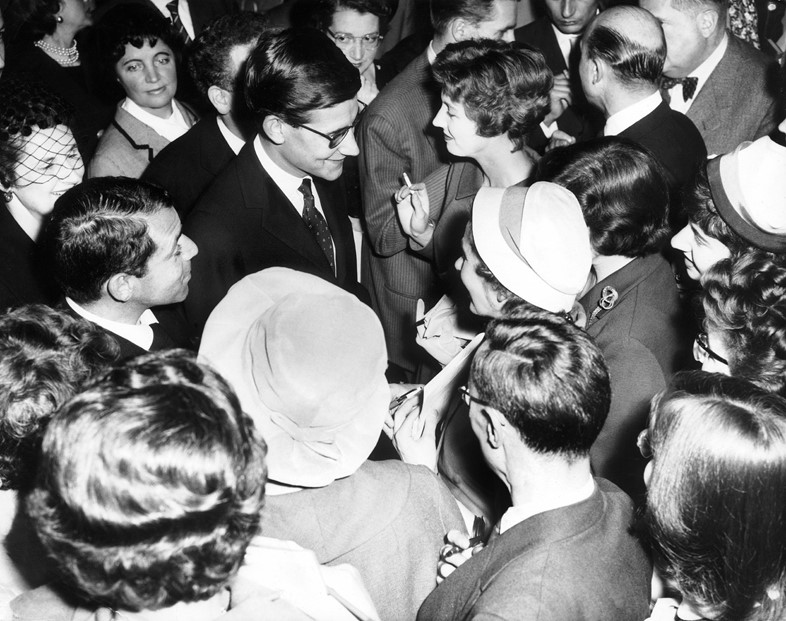As today marks ten years since the designer’s death, a collection of reflections on his legacy from those who encountered him
Yves Saint Laurent was that rare fashion powerhouse, of which few remain – a designer whose work spanned decades, and a changing world with them, and who responded to those changing times with clothes. Saint Laurent did so under his own name – YSL, as the acronym once went (designer Hedi Slimane dropped the “Yves” when he became creative director in 2012, and it has not since returned), became synonymous with the newly outfitted woman of the 1960s and 1970s, continuing to wield influence the decades since. She was a woman – his woman – who now comfortably wore trousers, cut like a tuxedo, day or night, a belted mac, a safari jacket, the sinuous silhouette of the 1940s, at once emancipated and defiantly glamorous. The numerous pieces he pioneered for women are now so ubiquitous, it feels as if they have been in their wardrobes all along. And, outside of the clothes themselves, he was an early, and passionate, proponent for diversity on the runway. Naomi Campbell would credit him as the reason she got her first cover of French Vogue.
Retired from the house in 2002 – paving the way for Tom Ford, Stefano Pilati, Hedi Slimane and Anthony Vaccarello to follow in his wake there – the latter part of his life was undeniably tumultuous. “Every man needs aesthetic phantoms in order to exist,” he said in a retirement speech. “I have known fear and the terrors of solitude. I have known those fair-weather friends we call tranquilisers and drugs. I have known the prison of depression and the confinement of hospital. But one day, I was able to come through all of that, dazzled yet sober.”
Dazzled, or dazzling, is the word which sticks when considering the vast catalogue of work, and archive – stored still in Paris at 5 avenue Marceau – he left behind. The shows themselves now seem like from another time entirely – regularly stretching over 100 looks, they were characterised by an astute, unrestrained use of colour, and an imagination that would allow him to reach back through epochs, and jump between the salon and the street.
He was always most passionate though about the coterie of women, and men, who surrounded him. They were the ones who stoked the fires of his imagination – from Loulou de la Falaise to Paloma Picasso, and, of course, Catherine Deneuve, who would become a living, breathing embodiment of his woman. It was her too, in his most troubled times, who would lend her arm as he struggled to take his final bow on the catwalk. Here, ten years since his death, a collection of reminiscences on the designer’s legacy, from those who encountered him.

Christian Lacroix, designer
“Chanel, Schiaparelli, Balenciaga and Dior all did extraordinary things. But they worked within a particular style. Yves Saint Laurent is much more versatile, like a combination of all of them. He’s got the form of Chanel with the opulence of Dior and the wit of Schiaparelli.”
Catherine Deneuve, actress
“Saint Laurent designs for women with a double life. His clothes for daywear help women to enter a world full of strangers. They enable her to go wherever she wants without arousing unwelcome attention, thanks to their somehow masculine quality. However, for the evening, when she may choose her company, he makes her seductive.”
Pierre Bergé, co-founder of Yves Saint Laurent
“Saint Laurent gave power to women. When a woman was insecure, Saint Laurent garments gave them security. It’s true.”
Tim Blanks, fashion critic
“For anyone who grew up – as I did – on the distant margins of human civilisation, Yves Saint Laurent was just about the only fashion name that registered… Saint Laurent was fashion’s equivalent of Andy Warhol, the anomic genius with the dazzling, decadent entourage.”
Naomi Campbell, model and actress
“He had a twinkle in his eye. I think he was the first designer to put women of colour on the catwalks, and I’m so grateful to him for that, for giving us a chance to be there. Every other designer has been inspired by him in some way.”
Vivienne Westwood, designer
“He pushed his talent to the limit. He worked so hard, even though it looked so simple: [his work] was flawless, he never failed to enhance the beauty of women.”
Mounia, model
“I was his first black muse – he helped open the door for black models. Sometimes I was his confidante, and I would sometimes inspire his creativity.”
Madeleine Renaud, actress
“Yves Saint Laurent has the genius of a poet and when he dresses a body its soul appears.”
